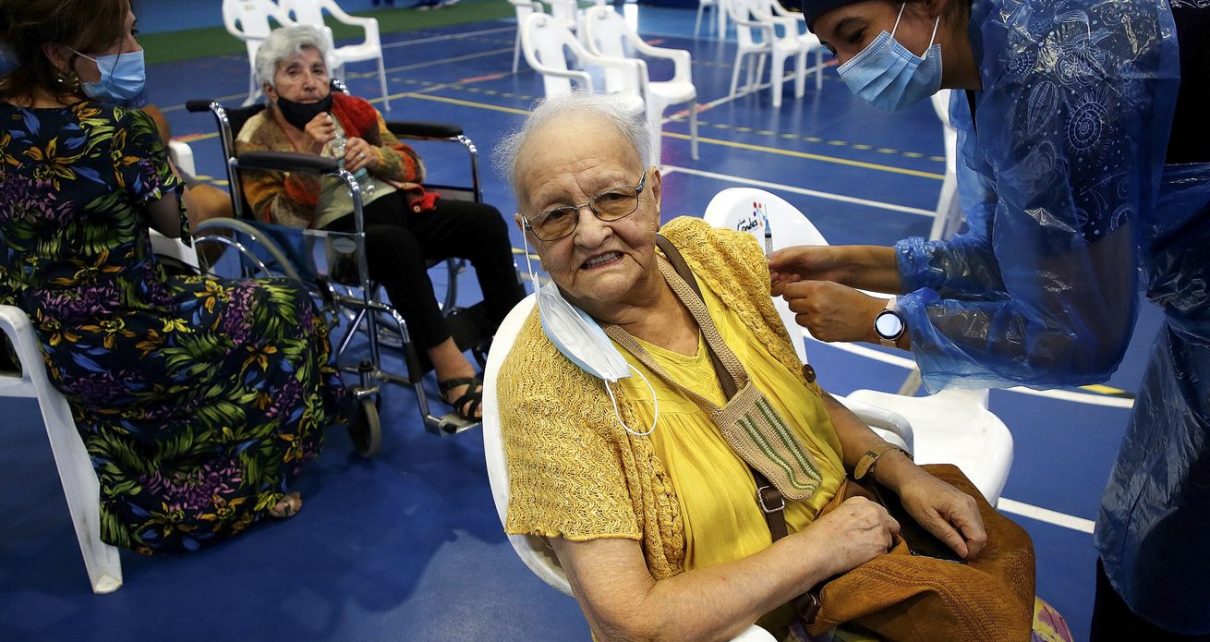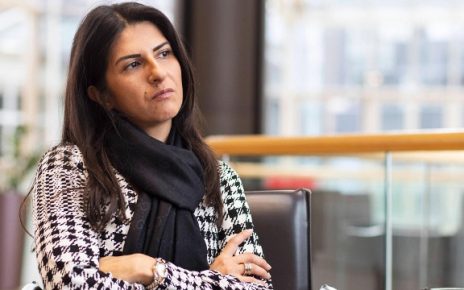
The Latin American country bet big on vaccines and relied on a strong primary health care network. Now, a quarter of the country has at least one shot.
Dr. Joxelin Flores Taborda, who is based in Santiago, Chile, got her second dose of Coronavac last week. She had a little headache afterward. But “a good headache,” she called it. “I was thinking, ‘The vaccine is doing something inside me.’”
Flores is a pediatrician who specializes in pulmonology. She and her colleagues who work in health care were among the first to receive vaccines at the start of Chile’s Covid-19 vaccination campaign in early February.
Since then, Chile has administered about 5 million vaccine doses, giving at least one shot to nearly a quarter of its population of around 19 million. The country’s vaccination campaign has far outpaced the rest of Latin America and much of the world. Chile has set a goal of delivering at least one dose to 15 million people by the end of June.
Getting vaccines was a priority, so Chile sought deals with many makers — making bets on many different types of vaccines from different places: China, the United Kingdom, the United States, and through the multilateral effort Covax. Chile also participated in phase 3 clinical trials for many vaccine candidates, which gave the country an edge in negotiating for doses.
“But we just didn’t have to have vaccines in Chile, we have to put the vaccines to the people. We have to inoculate,” Paula Daza, Chile’s vice minister for public health, told me. “And here, Chile has a history of successful vaccination campaigns where primary care plays a very, very elementary role in reaching the entire population.”
Chile did this by relying on already-in-place health infrastructure and a century-old tradition of mass immunization campaigns. “Chile has a robust primary health care system and a functional national immunization program with electronic records, which has helped set up a rapid, organized vaccination campaign,” Eduardo Undurraga, a public health expert and assistant professor at the Pontificia Universidad Católica de Chile, told me in an email.
Chile built on those systems by trying to meet people where they are, setting up vaccination sites at universities and stadiums. Chile’s Ministry of Health publishes a calendar that clearly says who’s eligible for a vaccine on what day, no appointment necessary. A national immunization registry means it’s easy to keep track of when people get their shots and when they’re due for their second dose, no matter where they are. The #YoMeVacuno (“I get vaccinated”) cards that people have been posing with on social media are just an added perk.
Chile’s Covid-19 record is, like so many other places, mixed: The country saw a big surge in new infections in its fall and winter months, forcing the country into a tight lockdown as cases threatened to overwhelm the health care system. Chile’s most vulnerable populations were also hit the hardest, a reality that reflected the larger debate playing out in Chile about the country’s inequality. All of this put pressure on the government and further deteriorated its popularity.
An effective vaccination campaign is an antidote to that. But Chile’s vaccination successes come as the country has seen some of its biggest coronavirus case spikes in months.
/cdn.vox-cdn.com/uploads/chorus_asset/file/22357819/chile_002.jpg) Martin Bernetti/AFP via Getty Images
Martin Bernetti/AFP via Getty ImagesStill, Chile’s vaccination campaign offers some relief. Roberto Orellana Ovalle, a hospital administrator who lives in the suburbs of Santiago, told me in an email that he found the vaccination process in Chile to be orderly, rapid, and efficient. He just had his second dose, and he is reassured that the grandparents in the country are getting their vaccines. His grandparents have all had at least their first doses; he had been afraid they might get Covid-19.
Flores too said the vaccine feels like hope. Her patients are kids, who were largely spared the worst of Covid-19. But many of Flores’s colleagues were called away to treat older patients. She, like so many other health care professionals, spent the past year feeling the weight of the pandemic.
“We don’t know if it’s going to end,” Flores said. “But at least the hope is tangible. It’s hope you can feel.”
Chile bought a lot of vaccine doses — from everyone
Chile reported its first case of Covid-19 on March 3, 2020. Planning for the country’s vaccination campaign began in the weeks after that, in April and May, Daza, Chile’s vice minister for public health, said. According to her, the different ministries of Sebastian Piñera’s government — science and technology, health, and international affairs, just to name a few — all coordinated on a plan to seek out safe and effective vaccines.
The idea was to get a big portfolio of vaccines, all of which relied on slightly different technologies. And to get them from as many different makers as possible. “Early on they really diversified — they looked at Western, as well as some of the Chinese, products. They joined Covax,” Katherine Bliss, a senior fellow in global health policy at the Center for Strategic and International Studies (CSIS), told me.
Chile spread its risk around, making these pre-purchase deals even before the vaccines’ efficacy and safety were confirmed. “They purchased from different mechanisms, and way ahead of time,” Arachu Castro, the Samuel Z. Stone Endowed Chair of Public Health in Latin America at Tulane University, told me.
“Because they purchased more vaccines than were needed to cover the population, that, of course, has also been criticized for limiting access to other countries. But definitely for the Chilean population, it’s been an advantage.”
Chile also opened itself up to host phase 3 clinical trials for several Covid-19 vaccine candidates, including for Sinovac’s Coronavac, and the ones made by Johnson & Johnson, AstraZeneca, and CanSino Biologics, Inc., a Chinese pharmaceutical company. This “gave them both experience with the different vaccines and the different companies, but also perhaps an edge in terms of negotiating access to doses,” Bliss said.
/cdn.vox-cdn.com/uploads/chorus_asset/file/22357815/chile_001.jpg) Xinhua News Agency/Getty Images
Xinhua News Agency/Getty Images/cdn.vox-cdn.com/uploads/chorus_asset/file/22357828/GettyImages_1292878493.jpg) Marcelo Hernandez/Getty Images
Marcelo Hernandez/Getty ImagesAnd Chile really does have a lot of promised vaccine doses on the books. As of March 1, according to the Ministry of Finance, the country has an agreement for 14 million doses with Sinovac (of which they’ve already received nearly 10 million); 10 million doses from Pfizer/BioNTech (of which they’ve received about 700,000); up to 4 million from AstraZeneca; and up to 4 million one-shot vaccines from Johnson & Johnson.
Chile is also a contributing member to Covax, the multilateral vaccine effort, and is expecting 7.6 million doses through that facility. Covax is delivering vaccines for free to dozens of low-income countries, but contributors like Chile also have access to the facility’s vaccine portfolio, and, in return, get the ability to choose which vaccine candidates they receive from Covax, Magdalena Bastías, a representative for the Pan-American Health Organization, told me in an email.
Chile is also reportedly negotiating with the Institute Gamaleya in Russia for its Sputnik V vaccine and with the Chinese-Canadian company CanSino Biologics.
In other words, they’re buying from pretty much everyone, everywhere. To do this, Chile deployed a kind of agnostic vaccine diplomacy. “They decided not to align themselves geopolitically,” Castro, of Tulane University, said.
If a country or company was making a vaccine, Santiago was open to it. “One of the most important things is that political considerations were not put on the table, never,” Daza said. “It was science, it was technical.”
Some experts also credited Chile’s openness and free-trade policies under the administration of the center-right president Sebastian Piñero for the country’s success in acquiring vaccines.
For some, it’s proof that there is a benefit to having a former billionaire businessman who is an efficient dealmaker in charge of the country. Others point to a successful vaccination campaign as Piñera’s only lifeline out of his poor handling of the pandemic and abysmal approval ratings, fueled by social and political unrest in Chile that predated the pandemic.
But experts also noted the country did put a particularly big bet on the Beijing-based pharmaceutical company Sinovac, which manufactures the Coronavac vaccine. Cristóbal Cuadrado, an assistant professor at the school of public health at the Universidad de Chile, told me that this was a bit of a gamble on Chile’s part, though it’s one that has paid off.
This was a wager partially driven by necessity, as Chile would have a much easier time getting to the front of the line for these doses.
That’s because many of the world’s high-income countries, like the United States or European Union, were not trying to make deals for the Sinovac vaccine. That gave Chile a degree of access and priority that might have been tougher with big manufacturers like Pfizer and AstraZeneca.
Cuadrado also pointed out that Chilean universities already had some longstanding partnerships with Chinese researchers, including collaborations on vaccines, and the Chilean government invested in those partnerships for the Covid-19 vaccine.
/cdn.vox-cdn.com/uploads/chorus_asset/file/22357855/chile_004.jpg) Martin Bernetti/AFP via Getty Images
Martin Bernetti/AFP via Getty ImagesThis also helped bring public legitimacy to the Sinovac vaccine that was otherwise being somewhat ignored by Western countries, Cuadrado said — which also helped mitigate some of the public skepticism around the Sinovac vaccine.
Undurraga, the public health expert at Pontificia Universidad Católica de Chile, told me public opinion polls in Chile suggest that people favor Covid-19 vaccines made in Europe or the United States over China or Russia — but that, above all else, people want to get vaccinated as soon as possible. There have been some questions about the Sinovac vaccine’s efficacy and transparency that have raised concerns, but, Undurraga said, “there is substantial agreement that the vaccine will save many lives.”
Sinovac’s Coronavac is the dose most Chileans are getting right now, making up the bulk of the more than 4 million distributed, compared to just hundreds of thousands who have gotten the Pfizer/BioNTech vaccine. Those I’ve talked to who’ve gotten the Coronavac vaccine all say the same thing: Any vaccine is better than none at all.
And, as it stands now, Chile has more than enough committed vaccine doses to vaccinate its population more than twice over. That, though, is just the first part of the equation.
“The government of Chile was able to secure a high amount of vaccines, and that has been an achievement,” Francisca Crispi, a professor of public health at the Universidad de Chile and the president of the Colegio Medico for the Santiago region, told me. “But, on the other hand, how do you get those vaccines to people all over the country?”
It helps to have experience with immunization programs
Chile doesn’t have a huge population, but the population it does have is spread across the country’s more than 3,000-mile length along South America’s western coast, along with some rural and remote areas.
To get Covid-19 vaccine doses into people’s arms, Chile relied on its deep experience with mass immunization programs and its public primary-health care system that works all over the country.
/cdn.vox-cdn.com/uploads/chorus_asset/file/22355003/GettyImages_641462316.jpg) Encyclopaedia Britannica/Universal Images Group via Getty Images
Encyclopaedia Britannica/Universal Images Group via Getty Images Chile has a hybrid public-private health care model, which has been criticized for creating inequities in care. But its strong public primary-health care network has served as the backbone of the Covid-19 vaccination campaign. Public clinics exist in communities across the country, and they’re deeply connected to those communities, too.
That system has traditionally helped carry out vaccination campaigns, of which Chile also has a long tradition. Chile’s National Immunization Program has roots that go back more than a century, to efforts in the late 1800s against smallpox. The country has undertaken a seasonal flu campaign since the 1980s, and the program also has practice launching rapid vaccination campaigns in response to emergencies like natural disasters, the Pan-American Health Organization’s Bastías said.
This existing infrastructure and experience allowed Chile to be ready to start a Covid-19 vaccination campaign “from day zero,” Rafael Araos, scientific adviser for Covid-19 with Chile’s Ministry of Health, wrote in an email.
/cdn.vox-cdn.com/uploads/chorus_asset/file/22357869/GettyImages_1231185935.jpg) Martin Bernetti/AFP via Getty Images
Martin Bernetti/AFP via Getty Images“Once vaccines eventually arrived, we were able to distribute and vaccinate the population efficiently,” Araos said. “People know and trust the program from successful prior experiences, which is also super important to succeed.”
Beyond public health clinics, Chile set up mobile vaccination centers in markets, universities, and soccer stadiums, and even created drive-through centers for shots. The country has now established more than 1,400 vaccination centers.
“They’ve done a really good job of going to universities and markets and other places where people are, as opposed to them having to come into a central location” to get the vaccine, CSIS’s Bliss said.
Chile’s national immunization registry also makes it easy to keep track of everyone’s vaccination status because everyone is on the same system. “You can easily know when a person has to get their doses, what vaccine was used,” Cuadrado said.
That also makes it easier for Chileans to get their second dose, and they can pretty much go wherever they’d like. “If you are, for example, on holiday or whatever, you can go just to the closest center that you find,” Cuadrado added.
Chile also had a pretty orderly rollout because its vaccination schedule is, well, a literal schedule. The campaign prioritized front-line health care workers, and then elderly people, starting from 90 or above and descending in age from there. Teachers and educators also got priority, as Chile’s school year began in March. Now, the country is vaccinating those with underlying vulnerabilities.
Each day of the week is assigned to a certain group. For example, on Wednesday, March 10, people who are 55 and 54 with underlying conditions or severe disabilities are eligible for the shot. On Thursday, it’s people between the ages of 53 and 50 years olds with comorbidities, and so on from there. The calendar is set by the Ministry of Health and is the same for all Chileans, regardless of what municipality they’re in.
You don’t need to speak Spanish to see how simple and straightforward the schedule is:
/cdn.vox-cdn.com/uploads/chorus_asset/file/22354570/Screen_Shot_2021_03_08_at_2.53.38_PM.png) Chile Ministry of Health
Chile Ministry of HealthAll people have to do is find the most convenient vaccination site in their region or community and go from there. Nobody has to make an appointment. Anyone who’s up for their second shot is also free to walk in wherever and get it.
It is the exact opposite of the morass of requirements and appointment systems in countries like the United States.
As Jon Andrus, a global vaccine expert at George Washington University and former deputy director at the Pan American Health Organization, put it: “Being able to have policy and a plan of action, a sheet of music that everybody’s reading from — that’s critical.”
Chile’s vaccination story is an early success. But it’s still early.
Chile has essentially met its initial goal of vaccinating 5 million people by the end of March. According to Daza, Chile’s vice minister for public health, almost 80 percent of people over 70 have already received at least one vaccine dose, and about 65 percent of those over 60 have gotten one.
But Chile is still in the early days of its campaign. Though the country has secured a lot of doses, it doesn’t yet have all its doses in hand for the entire population — though, again, Chile’s decision to try to get shots from many different places makes this a little less risky.
The country is also struggling to contain the Covid-19 pandemic; a little more than 20 percent of the population has gotten one shot, but new cases are now spiking to around 5,000 a day, some of the highest levels in months. Public health experts are desperately trying to balance the good news of vaccinations with attempting to convince the public of the continued need for masks and social distancing.
And though Chile may be the vaccination leader in Latin America, its neighbors’ comparatively slow and tiny vaccination campaigns mean controlling the pandemic will be even harder. “It’s a race against the variants right now,” Andrus said. Chile has donated some 40,000 doses of Sinovac — 20,000 each to Ecuador and Paraguay — to help in their vaccination efforts, but it is not even close to what’s needed on the continent.
Vaccine hesitancy is also a concern, though experts said they see Chile and its long tradition of robust vaccination programs as blunting the kind of skepticism seen in other parts of the world, and helping to overcome even initial concerns about new Covid-19 vaccines specifically. According to a recent survey, more than 72 percent of Chilean respondents said they would get the Covid-19 vaccine.
/cdn.vox-cdn.com/uploads/chorus_asset/file/22357864/AP_21056665757360.jpg) Esteban Felix/AP
Esteban Felix/AP/cdn.vox-cdn.com/uploads/chorus_asset/file/22357865/GettyImages_1231205093.jpg) Claudio Santana/Getty Images
Claudio Santana/Getty ImagesCrispi of the Universidad de Chile told me that experts, public health officials, and universities strove for a “common discourse” that clearly communicated to the public the safety and efficacy of the vaccines. Importantly, Crispi said, many of these people were outside of government, which is particularly unpopular in Chile.
“That was very important because of the skepticism that existed on the one hand toward the government, but also because the vaccines are new and we know there is a lot of [misinformation] going around about them,” Crispi said.
And as effective as Chile’s primary health care system has been in supporting the vaccination campaign, there are concerns about what that means for health care equity more broadly.
The pandemic, in general, has eclipsed regular health care services, and now the vaccination program might continue to do so, especially when it comes to things like child and maternal health, Tulane University’s Castro told me. “It’s like a double-edged sword,” she said. “[Chile’s] primary health care strategy is facilitating the rollout of the vaccines at the expense of essential services.”
This has also brought up bigger questions about equity. Chile’s divided health care system means those who have access to the private system tend to have a lot more privileges. But in the case of vaccinations, it’s the public health system that is the star.
This matters because last October, Chile announced that it would rewrite its constitution. In October 2019, a protest over a metro fare hike transformed into a broader fight over inequality in Chile, and that political momentum has now given Chile the chance to rewrite its laws.
Elections for those who will serve on this new Constitutional Committee are expected to be held in April, and the question is how the pandemic, and this vaccination campaign, might shape the candidates who are selected to reform Chile’s political system.
“I think there are some voices that are willing to learn from this pandemic and learn from the vaccination process, and to promote a health system that is more equitable, that unites us as a country,” Crispi said.
But that vaccination campaign itself, Crispi added, is still “a story that is to be written.”





